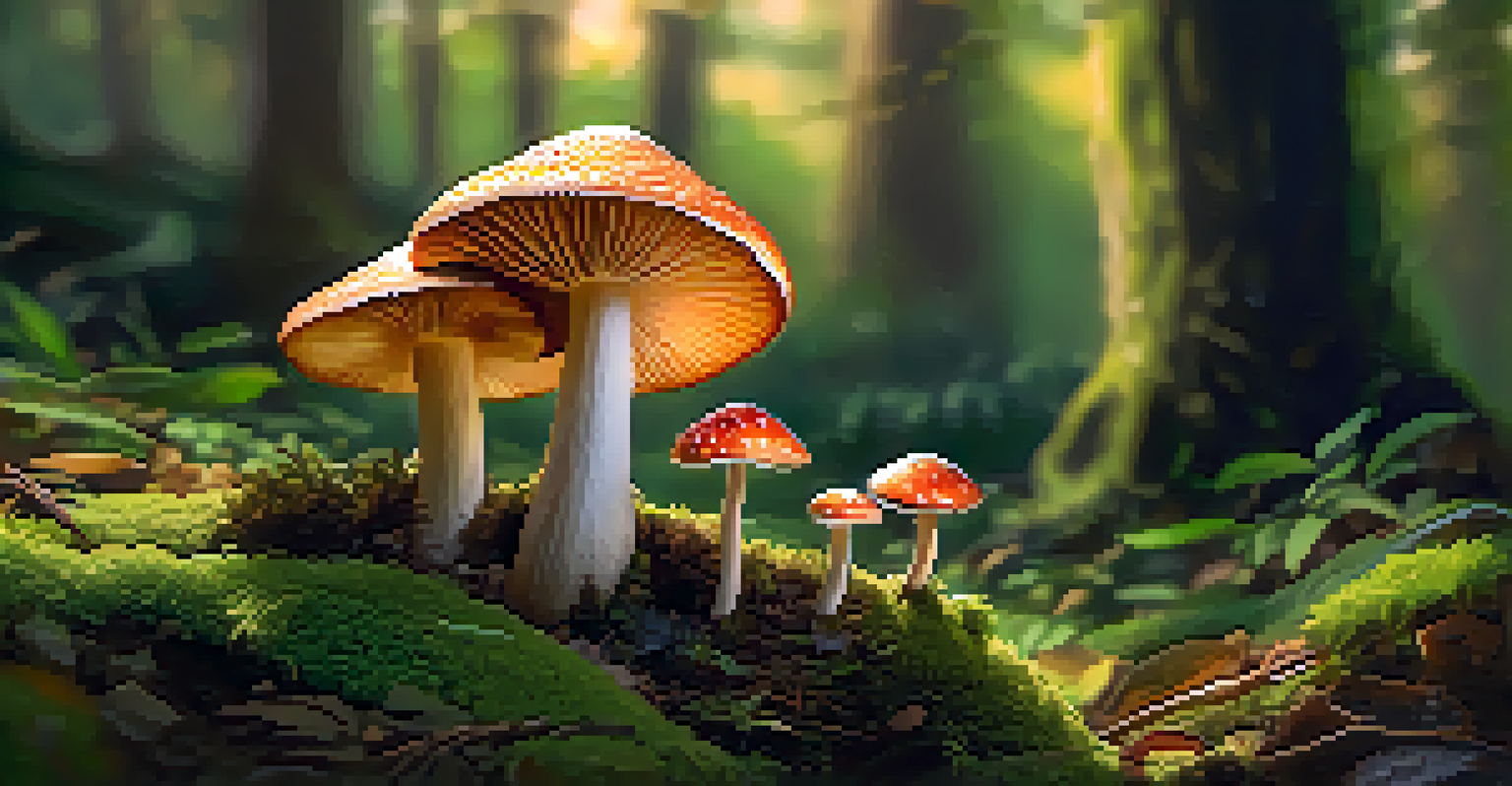Comparative Study of Peyote and Other Psychoactive Plants

Understanding Peyote: A Unique Psychoactive Cactus
Peyote, a small cactus native to Mexico and the southwestern United States, is known for its psychoactive properties. Its primary ingredient, mescaline, has been used for centuries in spiritual and healing practices among indigenous peoples. This unique relationship between peyote and its users sets it apart from many other psychoactive plants.
The use of psychoactive substances in traditional cultures is often rooted in a profound respect for nature and the spiritual world, emphasizing healing, community, and self-discovery.
Unlike more commonly known psychoactive substances, such as marijuana or psilocybin mushrooms, peyote is often consumed in a ceremonial context. These rituals emphasize connection to nature, community, and self-discovery, providing a profound experience that transcends mere recreational use. Understanding this cultural backdrop is crucial for appreciating peyote’s role in spiritual practices.
In comparison to other plants, peyote offers a distinct set of effects, often described as deeply introspective and transformative. Users frequently report vivid visual experiences and a heightened sense of emotional clarity. This contrasts with the effects of plants like cannabis, which may induce relaxation or euphoria, showcasing the diverse experiences offered by different psychoactive plants.
Exploring Psilocybin Mushrooms: Nature’s Hallucinogens
Psilocybin mushrooms, often called magic mushrooms, are another fascinating psychoactive plant. They contain the compound psilocybin, which converts to psilocin in the body, leading to altered perceptions and emotional states. Like peyote, these mushrooms have a long history of use in spiritual ceremonies, particularly among indigenous cultures in the Americas.

The experience of consuming psilocybin mushrooms is often described as more whimsical and unpredictable compared to peyote. Users may encounter a range of sensations, from enhanced colors to profound insights about their lives. This variability can be both exciting and daunting, making the experience unique for each individual.
Psychoactive Plants and Culture
Psychoactive plants like peyote, psilocybin mushrooms, and ayahuasca hold deep cultural significance in various indigenous traditions, emphasizing their spiritual and communal roles.
When comparing psilocybin to peyote, one notable difference lies in the duration of the experience. Psilocybin trips can last anywhere from four to six hours, while peyote effects might extend to twelve hours or more. This longer duration can create a more extended journey into self-exploration, appealing to those seeking a deeper connection with their inner selves.
Ayahuasca: A Brew for Spiritual Awakening
Ayahuasca is a traditional Amazonian brew made from the Banisteriopsis caapi vine and other plants, notably the Psychotria viridis leaf, which contains DMT. This powerful combination creates intense psychoactive experiences often described as visionary and life-changing. While peyote and psilocybin have their roots in North America, ayahuasca is deeply embedded in the spiritual practices of South American indigenous tribes.
Nature itself is the best physician, and substances like ayahuasca and peyote serve as tools to connect us to our deeper selves and the universe.
The experience of consuming ayahuasca can be quite intense, often involving purging, which is seen as a form of cleansing. Many participants emerge from their sessions feeling renewed or transformed, having confronted personal traumas or gained insights into their lives. This cleansing aspect differentiates ayahuasca from peyote and psilocybin, which do not typically involve such physical responses.
In terms of duration, an ayahuasca journey can last between four to eight hours, similar to psilocybin but often more intense and profound. This extended period allows users to delve deep into their subconscious, promoting exploration and emotional healing. The communal aspect of ayahuasca ceremonies also fosters a supportive environment, enhancing the overall experience.
Comparative Effects: Peyote vs. Other Psychoactive Plants
When examining the effects of peyote compared to other psychoactive plants, it's important to recognize the emotional and psychological dimensions each offers. Peyote is often associated with deep introspection and connection to one’s spiritual self, while psilocybin mushrooms can lead to a more visual and unpredictable experience. Ayahuasca, on the other hand, tends to facilitate intense emotional releases and personal revelations.
The onset time also varies across these plants. Peyote’s effects may take about 30 to 90 minutes to manifest, while psilocybin can kick in relatively quickly, sometimes within 20 minutes. Ayahuasca, however, has a delayed onset due to the digestive process, which can influence how participants prepare for their journey.
Health Benefits and Risks
While psychoactive plants can offer therapeutic benefits, such as alleviating anxiety and depression, they also pose risks that require careful consideration and support.
These differences in effects and onset times contribute to why individuals may choose one plant over another based on their personal goals for the experience. Whether seeking clarity, creativity, or spiritual awakening, understanding these distinctions can help guide individuals towards the appropriate plant for their needs.
Cultural Significance of Peyote and Its Peers
Psychoactive plants like peyote, psilocybin mushrooms, and ayahuasca hold deep cultural significance in the traditions of various indigenous peoples. Peyote, for instance, is central to the Native American Church, where it is viewed as a sacred tool for prayer and connecting with the divine. This cultural reverence underscores the importance of context in understanding the use of these plants.
In contrast, psilocybin mushrooms have been used for centuries by indigenous groups in Mesoamerica, often in rituals aimed at divination and healing. The cultural practices surrounding these plants highlight how they are not merely substances for recreational use but essential components of spiritual and communal life.
Ayahuasca's significance in Amazonian culture is equally profound, often serving as a bridge between the physical and spiritual worlds. Shamans use ayahuasca in healing ceremonies, guiding participants through their journeys. Recognizing the cultural contexts of these plants enriches our understanding of their effects and applications in modern society.
Legal Status and Accessibility of Psychoactive Plants
The legal status of peyote and other psychoactive plants varies significantly around the world, impacting their accessibility for users. In the United States, peyote is classified as a Schedule I substance, making it illegal for general use but permissible for members of the Native American Church under specific circumstances. This creates a complex landscape for those interested in exploring peyote’s benefits.
Psilocybin mushrooms have seen a shift in legal status in some areas, with cities like Denver and states like Oregon decriminalizing or regulating their use. This changing landscape reflects a growing recognition of the potential therapeutic benefits of psilocybin, particularly in treating mental health conditions such as depression and anxiety.
Legal Status Variances
The legal status of peyote, psilocybin mushrooms, and ayahuasca varies globally, affecting accessibility and highlighting the importance of cultural context in their use.
Ayahuasca, although not universally legal, has gained popularity in ayahuasca retreats, often situated in countries like Peru or Brazil, where its use is culturally accepted. These retreats provide a structured and supportive environment for participants, highlighting the importance of legal frameworks that respect cultural practices while also promoting safety.
Health Benefits and Risks of Psychoactive Plants
Psychoactive plants like peyote, psilocybin mushrooms, and ayahuasca are often cited for their potential health benefits. Research has shown that mescaline can help alleviate anxiety and improve the emotional well-being of users. Similarly, psilocybin has gained attention for its promising results in treating depression and PTSD, showcasing the therapeutic potential of these natural substances.
However, it’s essential to approach these plants with a sense of caution. While many users report positive experiences, others may encounter challenging trips that can lead to psychological distress. Understanding individual mental health conditions and ensuring the presence of a supportive environment can mitigate some risks associated with these experiences.

Ayahuasca, while praised for its healing properties, can also pose health risks, particularly for individuals with certain medical conditions or those taking specific medications. This highlights the importance of thorough preparation and consultation with knowledgeable practitioners before engaging in these experiences. Ultimately, recognizing both the benefits and risks allows individuals to make informed decisions about their use.